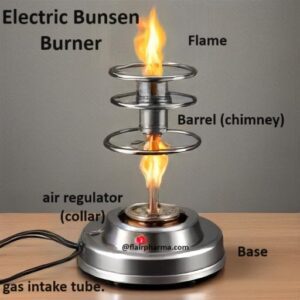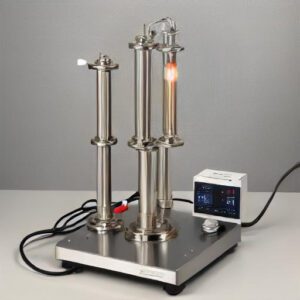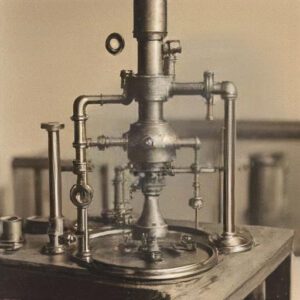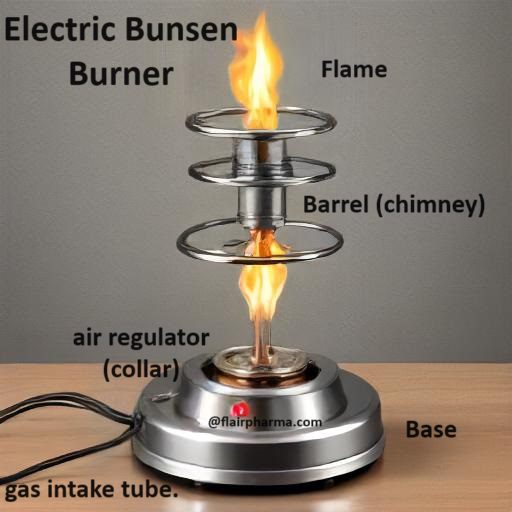The electric Bunsen burner represents a significant advancement in laboratory heating equipment, offering a safer, more precise, and environmentally friendly alternative to traditional gas-powered Bunsen burners. This comprehensive article explores the various aspects of the electric Bunsen burner, including its components, working principle, types, applications, advantages, limitations, and future prospects.
Evolution and Need for Electric Bunsen Burners:
The traditional Bunsen burner, invented by Robert Bunsen in 1857, has been a staple in laboratories for over a century. However, the reliance on open flames and gas sources poses several risks, including fire hazards, gas leaks, and inconsistent heating. The electric Bunsen burner was developed to mitigate these risks and provide a more controlled heating environment.
Transition to Electric Bunsen Burners
The transition to electric Bunsen burners is driven by several factors:
- Safety: Eliminates the risk of gas leaks and open flames, reducing fire hazards.
- Precision: Offers precise temperature control, which is crucial for many scientific experiments.
- Environmental Concerns: Reduces the reliance on fossil fuels and minimizes greenhouse gas emissions.
Components of an Electric Bunsen Burner
An electric Bunsen burner consists of several key components designed to mimic the functionality of traditional gas burners while providing enhanced control and safety features.
Key Components:
- Base: A sturdy and stable foundation that supports the burner and houses the electrical connections.
- Heating Element: A high-resistance coil or ceramic element that generates heat when an electric current passes through it.
- Temperature Control: A digital or analog interface that allows users to set and monitor the temperature accurately.
- Safety Features: Includes automatic shut-off mechanisms, overheat protection, and insulated surfaces to prevent accidental burns.
- Power Supply: Connects the burner to an electrical outlet, typically featuring adjustable voltage settings.
Working Principle
The electric Bunsen burner operates on the principle of electrical resistance heating. When an electric current flows through the heating element, it encounters resistance, causing the element to heat up. This heat is then transferred to the substance or apparatus being heated.
Detailed Working Mechanism
- Power On: The burner is connected to an electrical power source, and the temperature control is set to the desired level.
- Heating: The electric current flows through the heating element, generating heat.
- Temperature Regulation: The temperature control system monitors the heat generated and adjusts the current flow to maintain the set temperature.
- Safety Mechanisms: If the temperature exceeds safe levels, the automatic shut-off feature activates to prevent overheating.
Types of Electric Bunsen Burners
Electric Bunsen burners come in various designs and specifications to cater to different laboratory needs.
Classification Based on Design and Functionality
- Standard Electric Bunsen Burners: Basic models with manual temperature control and safety features.
- Advanced Digital Burners: Equipped with digital displays, programmable settings, and enhanced safety mechanisms.
- Portable Models: Lightweight and battery-operated for fieldwork and remote experiments.
- High-Precision Burners: Designed for specialized applications requiring extremely accurate temperature control.

Technical specifications for Electric Bunsen Burners:
| Specification | Details |
| Power Source | Electric |
| Voltage | 110-240V AC |
| Power Consumption | 300-1000W |
| Heating Element | High-resistance coil or ceramic element |
| Temperature Range | 50°C to 1200°C |
| Temperature Control | Digital or analog interface |
| Heating Time | 30 seconds to 5 minutes (depending on the model and settings) |
| Material | Stainless steel, ceramic, and high-heat resistant plastics |
| Dimensions | Varies by model (e.g., 10 cm diameter x 15 cm height) |
| Weight | 0.5 to 2 kg |
| Safety Features | Overheat protection, auto shut-off, insulated casing |
| Usage Modes | Continuous and intermittent heating |
| Heating Surface | Diameter of 5-10 cm |
| Portability | Compact and lightweight design |
| Certification | CE, UL, RoHS |
| Accessories | Power cord, stand, clamps (optional depending on the model) |
| Warranty | 1 to 2 years (depending on the manufacturer) |
| Applications | Laboratory heating, sterilization, chemical reactions |
| Noise Level | Silent or very low noise operation |
| Control Accuracy | ± 1°C |
| Display | LED or LCD (for digital models) |
| Safety Compliance | IEC/EN 61010-1 standard |
| Connector Type | Standard plug types (e.g., Type A, B, C, etc.) |
| Cooling Mechanism | Natural convection or built-in fan |
Applications of Electric Bunsen Burners:
Electric Bunsen burners are versatile tools used across various scientific disciplines.
In Chemical Laboratories:
- Heating and Boiling: Provides consistent and controllable heat for boiling liquids and heating solutions.
- Evaporation: Ideal for evaporating solvents in chemical reactions.
- Synthesis Reactions: Used in organic synthesis and other chemical reactions requiring precise temperature control.
In Microbiology Laboratories
- Sterilization: Sterilizes inoculating loops, spreaders, and other microbiological tools.
- Aseptic Techniques: Creates a sterile environment for culturing and handling microorganisms.
In Biological Research
- Sample Preparation: Prepares biological samples by heating and drying.
- Tissue Culture: Maintains sterile conditions for tissue culture experiments.
In Educational Institutions
- Demonstrations: Used in teaching laboratories for demonstrations and practical experiments.
- Student Laboratories: Provides a safe and controlled heating source for student experiments.
Advantages of Electric Bunsen Burners
Electric Bunsen burners offer several advantages over traditional gas burners.
Key Benefits
- Enhanced Safety: Eliminates the risks associated with open flames and gas leaks.
- Precision Control: Allows for precise temperature regulation, improving experimental accuracy.
- Environmental Friendliness: Reduces carbon footprint by eliminating the use of fossil fuels.
- Ease of Use: Simplifies operation with intuitive controls and automated safety features.
- Versatility: Suitable for a wide range of laboratory applications.
Limitations of Electric Bunsen Burners
Despite their advantages, electric Bunsen burners have some limitations.
Common Limitations
- Initial Cost: Higher upfront cost compared to traditional gas burners.
- Power Dependency: Requires a stable electrical power supply, limiting portability.
- Temperature Range: May have a limited temperature range compared to gas burners.
- Heat Distribution: Potential for uneven heat distribution in some models.
Safety Considerations
Safety is paramount when using any laboratory equipment, and electric Bunsen burners are no exception.
Safety Features
- Automatic Shut-Off: Prevents overheating by cutting off power if the temperature exceeds safe limits.
- Insulated Surfaces: Minimizes the risk of accidental burns.
- Stable Base: Ensures the burner remains upright and stable during operation.
- Overheat Protection: Monitors temperature and prevents overheating by adjusting current flow.
Best Practices
- Regular Maintenance: Perform regular checks and maintenance to ensure the burner operates safely and efficiently.
- Proper Handling: Use heat-resistant gloves and tools when handling hot equipment.
- Adequate Ventilation: Ensure the laboratory is well-ventilated to dissipate any heat generated.
Comparison with Traditional Gas Bunsen Burners
Comparing electric Bunsen burners with their traditional gas counterparts highlights their respective strengths and weaknesses.
Comparative Analysis
- Safety: Electric burners are safer due to the absence of open flames and gas leaks.
- Precision: Electric burners offer better temperature control and stability.
- Cost: Gas burners are generally cheaper initially but may incur higher long-term costs due to gas consumption.
- Environmental Impact: Electric burners are more environmentally friendly, reducing reliance on fossil fuels.
- Ease of Use: Electric burners are easier to operate with automated controls and safety features.
Future Prospects and Innovations
The future of electric Bunsen burners lies in continued innovation and technological advancements.
Emerging Trends
- Smart Burners: Integration with IoT for remote monitoring and control.
- Energy Efficiency: Development of more energy-efficient heating elements.
- Advanced Safety Features: Incorporation of AI and machine learning for predictive safety mechanisms.
- Portability: Enhanced portable models with longer battery life and higher performance.
Research and Development
Ongoing research aims to address the limitations of current models and expand their applications. Innovations in materials science and electrical engineering are expected to yield more efficient and versatile electric Bunsen burners.
Frequently asked Questions (FAQ’S)
What is the working principle of a burner?
Answer: A burner works on the principle of mixing fuel with air (oxygen) to create combustion. The fuel, typically gas, is ignited, and the controlled flame is used for heating, sterilizing, or combustion purposes.
What principle is the Bunsen burner an application of?
Answer: The Bunsen burner operates on the principle of the Venturi effect, which involves drawing air into the burner as gas flows through it. This mixture of gas and air is then ignited to produce a controlled flame.

What is the function of the Bunsen burner?
Answer: The function of a Bunsen burner is to provide a safe, controlled source of heat for various laboratory applications, such as heating substances, sterilizing equipment, and supporting chemical reactions.
How does a Bunsen burner work simple?
Answer: A Bunsen burner works by mixing gas with air in a controlled manner. Gas flows through the burner’s tube and mixes with air entering through adjustable air holes. This mixture is ignited at the top, producing a flame.
How does an electric Bunsen burner work?
Answer: An electric Bunsen burner works by using an electric current to heat a high-resistance element, such as a coil or ceramic. The element heats up and transfers this heat to the substance being heated. Temperature is controlled using a digital or analog interface.
What are the working principles of Bunsen burner?
Answer: The Bunsen burner works on the principles of gas and air mixing, combustion, and the Venturi effect. It involves controlling the gas and air mixture to produce a flame of varying intensity and temperature.
How does an electric burner work?
Answer: An electric burner works by passing an electric current through a high-resistance heating element. This resistance generates heat, which is then used to heat up the surface or the substance placed on it. Temperature control systems regulate the heat output.
What are the three types of burners?
Answer:
- Tirrill Burner: Allows fine control of both gas and air supply.
- Teclu Burner: Features a longer tube for better mixing of gas and air.
- Meker Burner: Has a larger barrel diameter and a grid for a more powerful flame.
What is the principle of pilot burner?
Answer: A pilot burner operates on the principle of maintaining a small, continuous flame that ignites the main burner when gas is supplied. It ensures that the main burner can be ignited safely and promptly.
Why Bunsen burner is mostly used?
Answer: The Bunsen burner is mostly used because it provides a controlled, adjustable flame for various laboratory tasks. It is versatile, easy to use, and suitable for heating, sterilization, and combustion processes in scientific experiments.
Why is it called a Bunsen burner?
Answer: It is called a Bunsen burner after Robert Bunsen, the German scientist who developed it in collaboration with Peter Desaga in 1857.
How can a Bunsen burner be used?
Answer: A Bunsen burner can be used for:
- Heating chemicals
- Sterilizing laboratory equipment
- Performing flame tests
- Supporting chemical reactions
- Melting substances
What is the theory of Bunsen burner?
Answer: The theory of the Bunsen burner involves the mixing of gas with air to produce a controlled flame, using the principles of combustion and the Venturi effect to draw air into the gas stream for efficient burning.
What energy is used in a Bunsen burner?
Answer: A Bunsen burner uses chemical energy from the fuel (typically natural gas or liquefied petroleum gas) which is converted into thermal energy through the process of combustion.
What are the rules for Bunsen burners?
Answer:
- Always check for gas leaks before use.
- Light the burner with a match or lighter, not directly.
- Adjust the air holes to control the flame.
- Never leave the burner unattended while lit.
- Turn off the gas supply when not in use.
What is the purpose of the Bunsen burner experiment?
Answer: The purpose of a Bunsen burner experiment is typically to demonstrate the principles of combustion, observe the different types of flames, or to heat substances for various chemical reactions.
What is the physics of the Bunsen burner?
Answer: The physics of the Bunsen burner involves principles of fluid dynamics (Venturi effect), thermodynamics (heat transfer), and combustion (chemical reaction between fuel and oxygen producing heat and light).
How does a burner work?
Answer: A burner works by mixing fuel with air in a controlled manner and igniting the mixture. The fuel burns, producing a flame that can be used for heating, cooking, or other applications.
What is the use of electric Bunsen burner?
Answer: An electric Bunsen burner is used for providing a controlled source of heat in laboratories, similar to a traditional Bunsen burner, but without the risks associated with open flames and gas leaks.
How can a Bunsen burner be lighted?
Answer: A Bunsen burner can be lighted by:
- Ensuring the gas supply is off.
- Opening the air holes slightly.
- Using a match or lighter, ignite the gas at the top of the burner.
- Slowly turn on the gas supply while keeping the flame source close to the burner’s top.
What are the three types of Bunsen flame?
Answer:
- Safety Flame: Yellow/orange, cool flame, produced with air holes closed.
- Medium Blue Flame: Blue, moderate temperature, produced with partially open air holes.
- Roaring Flame: Blue with an inner cone, hottest flame, produced with fully open air holes.
How important is the Bunsen burner?
Answer: The Bunsen burner is crucial in laboratory settings for its versatility in providing a reliable and adjustable heat source for various scientific experiments and procedures.
Why is blue flame hotter than yellow?
Answer: A blue flame is hotter than a yellow flame because it indicates complete combustion of the gas, with a higher ratio of oxygen. This results in a more efficient and hotter flame.
Who invented Bunsen burner?
Answer: The Bunsen burner was invented by Robert Bunsen and Peter Desaga in 1857.
How do you control a Bunsen burner flame?
Answer: The flame of a Bunsen burner is controlled by adjusting the air intake through the collar to regulate the air-fuel mixture, and by controlling the gas flow with the gas valve.
What is the principle of Bunsen burner in microbiology?
Answer: In microbiology, the principle of the Bunsen burner is to provide a sterile, aseptic environment by creating an updraft of hot air that prevents contaminants from settling on sterile surfaces.
What are the parts of a flame?
Answer: The parts of a flame typically include:
- Inner Core: Dark region at the center where incomplete combustion occurs.
- Middle Zone: Blue or luminous zone where complete combustion occurs.
- Outer Zone: Invisible hot region where the combustion is completed.
What is the function of a burner?
Answer: The function of a burner is to provide a controlled and efficient source of heat for various applications, such as cooking, heating, and scientific experiments.
What is the burner method?
Answer: The burner method refers to using a burner to apply heat for specific applications, such as heating solutions, performing combustion reactions, or sterilizing equipment in a laboratory.
What is the introduction of burner?
Answer: A burner is a device that mixes fuel with air or oxygen and ignites the mixture to produce a controlled flame for heating, cooking, or other applications. It is an essential tool in many laboratory and industrial processes.
How to operate a Bunsen burner?
Answer:
- Ensure the gas supply is off.
- Open the air holes slightly.
- Ignite the gas at the top with a match or lighter.
- Gradually turn on the gas supply.
- Adjust the air holes and gas flow to control the flame.
Why Bunsen burner is used in flame test?
Answer: A Bunsen burner is used in flame tests because it produces a consistent and clean flame, which allows for the observation of characteristic colors emitted by different metal ions when they are heated.
What is the function of a base in a Bunsen burner?
Answer: The base of a Bunsen burner provides stability and support, ensuring the burner remains upright during use. It also houses the gas intake and connections.
What is the principle of burner?
Answer: The principle of a burner is to mix fuel with air in the correct proportions and ignite the mixture to produce a flame. This involves principles of fluid dynamics and combustion.
What are the two main parts of a Bunsen burner?
Answer: The two main parts of a Bunsen burner are the barrel (chimney), where the gas and air mix and combust, and the base, which provides stability and houses the gas intake.
What are the three types of flames on a Bunsen burner?
Answer:
- Safety Flame: Yellow/orange, cool, and luminous.
- Medium Blue Flame: Blue and moderately hot.
- Roaring Flame: Blue with an inner cone, very hot and noisy.
Why is it called Bunsen burner?
Answer: It is called a Bunsen burner after Robert Bunsen, who developed it in collaboration with Peter Desaga to provide a safer and more efficient heat source for laboratory use.
What is Bunsen famous for?
Answer: Robert Bunsen is famous for his contributions to chemistry, including the invention of the Bunsen burner and his work in spectroscopy and photochemistry.
What is the coolest part of the Bunsen flame?
Answer: The coolest part of the Bunsen flame is the inner core, where the gas is not yet completely combusted, and the temperature is lower compared to the outer zones of the flame.


Hi, I’m Jack. Your website has become my go-to destination for expert advice and knowledge. Keep up the fantastic work!